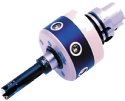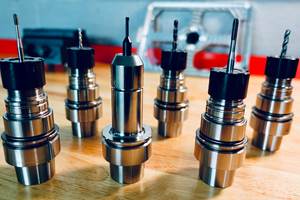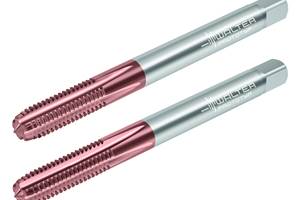Smart Boring Bar Auto-Comps
Because boring is a finishing or semi-finishing operation, there is generally little or no margin for dimensional or surface finish error. In production, dimensional accuracy of a precise bore can be negatively affected by tool wear over time.
Because boring is a finishing or semi-finishing operation, there is generally little or no margin for dimensional or surface finish error. In production, dimensional accuracy of a precise bore can be negatively affected by tool wear over time.
The goal is to track the tool wear in a predictable manner using SPC or other trend analysis techniques to determine when the boring bar needs to be compensated for tool wear and build the tool comp into the process. There are a number of methods to gather this tool wear data. These include in-process gaging, time-in-cut tables and acoustical analysis, all of which can tell the machinist a cutter is wearing near the upper tolerance limit.
In general manufacturing, once a tool comp is required, the machine tool operation must stop for operator intervention. For very precise boring, often the machine tool's resolution is insufficient for the very fine adjustment required.
In close tolerance boring, adjustable boring heads are used to provide very tiny radial adjustments that are outside the ability of the machine tool. Komet of America (Schaumburg, Illinois) recently introduced a new adjustable boring system that is capable of making tool compensation moves automatically, on the machine, without the need for operator intervention. Called the M042, this boring head is a marvel of miniaturization. Within its body is an electronic servomotor, slide system, infrared transceiver module for remote data signal reception and an integral inductive scale that gives absolute positioning for the cutter tip. The entire boring bar unit is designed to operate within an automatic tool changer system on a machining center. It is also built to operate in the harsh production machining environments of flex lines and special and transfer machines.
Komet's automatic compensating system is designed for fully automatic or unattended precision positioning of the cutting insert for finish boring operations. The system consists of an integral positioning mechanism, gaging equipment to measure and trend the workpiece bore, a control-unit and the boring bar itself.
Unlike most other auto-comp systems that use mechanical or hydraulic actuation of the tool slide, the electronic system is less influenced by outside parameters such as thermal growth. Moreover, the integral inductive scale provides absolute positioning feedback to the control unit.
If a positioning error occurs, the system software will send an error alert or re-try the programmed move. Using a scale system to measure absolute movement prevents mechanical errors caused by backlash or thermal distortion from transferring to the tool tip. The M042 has a stroke of 1 mm and can move in 1 micron increments.
A variety of gaging systems can be used with the auto-comp system. Its software is compatible with most protocols so gaging and compensation can be integrated. One auto-comp boring bar and gaging system for machining centers uses an automatic tool changeable plug gage to check the bore before and after machining. It then feeds the trending data back through the control and will automatically signal the need for a tool wear compensation routine when set parameters are hit. Another gaging variation accomplishes the same closed loop compensation feedback using a table mounted laser gage or touch gage to directly measure the cutting insert for wear without the need to interchange the cutting tool for a plug gage.
One M042 control unit can accommodate 15 boring units at a time. For tight tolerance boring where automation of the tool compensation routine makes sense, this unit may be a viable step forward. It would appear that smart tools are here.
Related Content
How Lowering Torque Improves Tapping Tool Life
Escaping the tap breakage trap requires a long look at torque and the many factors that influence it.
Read MoreWalter Offers New Solid-Carbide Taps for Blind-Hole Machining
Walter’s TC388 Supreme and TC389 Supreme feature patent-pending cutting geometries that fully shear off the root of the chip when reversing, thus minimizing torque peaks.
Read MoreHow to Tackle Tough Angled Pocket Milling With Two Tools
Milling a deep pocket with a tight corner radius comes with unique challenges, but using both a flat bottom drill and a necked-down finishing tool can help.
Read MoreTungaloy Expands Drill System With Drill Sleeves
Adding drill sleeves to the standard lineup enhances drilling productivity of Swiss-type sliding-head automatic lathes.
Read MoreRead Next
3 Mistakes That Cause CNC Programs to Fail
Despite enhancements to manufacturing technology, there are still issues today that can cause programs to fail. These failures can cause lost time, scrapped parts, damaged machines and even injured operators.
Read MoreThe Cut Scene: The Finer Details of Large-Format Machining
Small details and features can have an outsized impact on large parts, such as Barbco’s collapsible utility drill head.
Read More
















.png;maxWidth=300;quality=90)











